Hurricane scientists at AOML provided guidance and data support for National Hurricane Center (NHC) and Environmental Modeling Center (EMC) tasked reconnaissance into Hurricane Laura, identifying critical information about the system’s location, development, and intensification.
Beginning on August 20th, 11 P-3 and 6 G-IV missions were conducted, capturing the complex lifecycle of Laura until its eventual landfall in Louisiana on August 27th.
Measurements obtained during these missions allowed hurricane experts to evaluate up-to-date conditions within the system as it struggled to stay organized along the Greater Antilles, eventually converging on a center location south of the island chain (learn more here). The observations collected by dropsondes and onboard sensors, such as Tail Doppler Radar (TDR) and Stepped Frequency Microwave Radiometer (SFMR), were ingested into operational models to improve their performance.

In addition to completing operational requirements, objectives from AOML’s Intensity Forecasting Experiment (IFEX) were addressed. IFEX is a multiyear experiment intended to improve our understanding and prediction of hurricane intensity and structure change through the collecting of airborne observations.
“This dataset would not be possible without dedicated teamwork among AOML, NHC, EMC, the Aircraft Operations Center (AOC), and numerous project collaborators,” Hurricane Field Program director Lisa Bucci, PhD, explains as she comments on reconnaissance efforts into Hurricane Laura. She emphasizes that quick responses to the rapidly intensifying tropical cyclone (TC) led to additional accomplishments during the missions.
AOML hurricane scientists worked diligently to ensure that the measurements gathered during missions into the Laura provided insights into major questions defined at the start of the 2020 TC season. These topics include processes that a TC produces within its inner core as well as how the TC interacts with the environment in which it is embedded.

Data coverage from P-3 and G-IV reconnaissance into Laura allows hurricane experts to investigate the questions posed in multiple IFEX experiments regarding hurricane development, intensification, and structural processes contributing to the prediction of TC-related hazards.
Project principle investigators (PIs) worked with their team of experts to develop strategies unique to Laura and implemented them in real-time with the NOAA Hurricane Hunters to accomplish their objectives. Scientists at AOML’s Hurricane Research Division (HRD) reviewed all the missions during their debrief on Wednesday, September 2nd.
Knowledge of the formation of TCs continues to be an active research effort, which motivates the Genesis experiment’s goal to capture the transformation of a tropical disturbance to a tropical depression.

Jon Zawislak, PhD, HFP deputy operations director and a project PI for the Favorable Air Mass and Precipitation during Formation experiments, expressed excitement in obtaining relevant measurements that may shed light on how environmental conditions may be contributing to a TC’s potential to materialize.
“While not expecting to conduct a genesis mission, an interesting interaction of the system’s elongated circulation with the island chain allowed us to visualize how Laura was able to organize,” describes Gus Alaka, PhD, a fellow PI on both Genesis experiments.
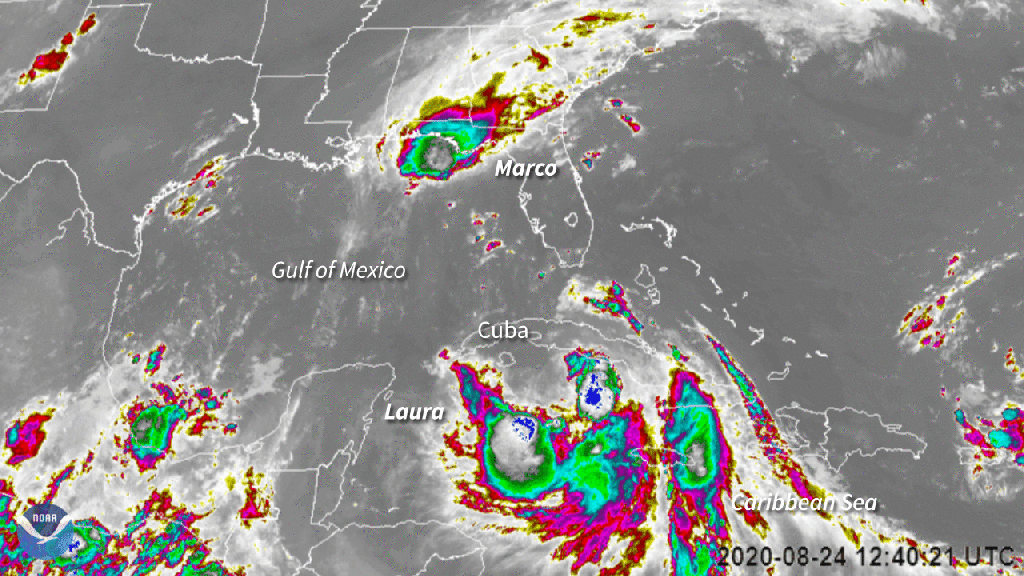
Laura’s complex formation was made more difficult to forecast due to Tropical Storm Marco, located in the Gulf of America. It’s circulation affected the environment around it and influenced the evolution of Laura’s vortex as it moved through the Caribbean (learn more here).
“Early in Laura’s lifecycle, interactions between then Tropical Storm Laura and Tropical Storm Marco added further uncertainty to both systems’ forecasts,” HFP deputy science director Jason Dunion, PhD, explains.
Scientists at AOML are part of a project that provided real-time guidance to help pinpoint where supplemental aircraft data could improve model forecasts for Hurricane Laura. Dunion, a Co-PI for the project, states “this research project successfully implemented its goal of providing NHC with experimental guidance for NOAA’s operational G-IV missions in Hurricane Laura”, as funded by Joint Hurricane Testbed.
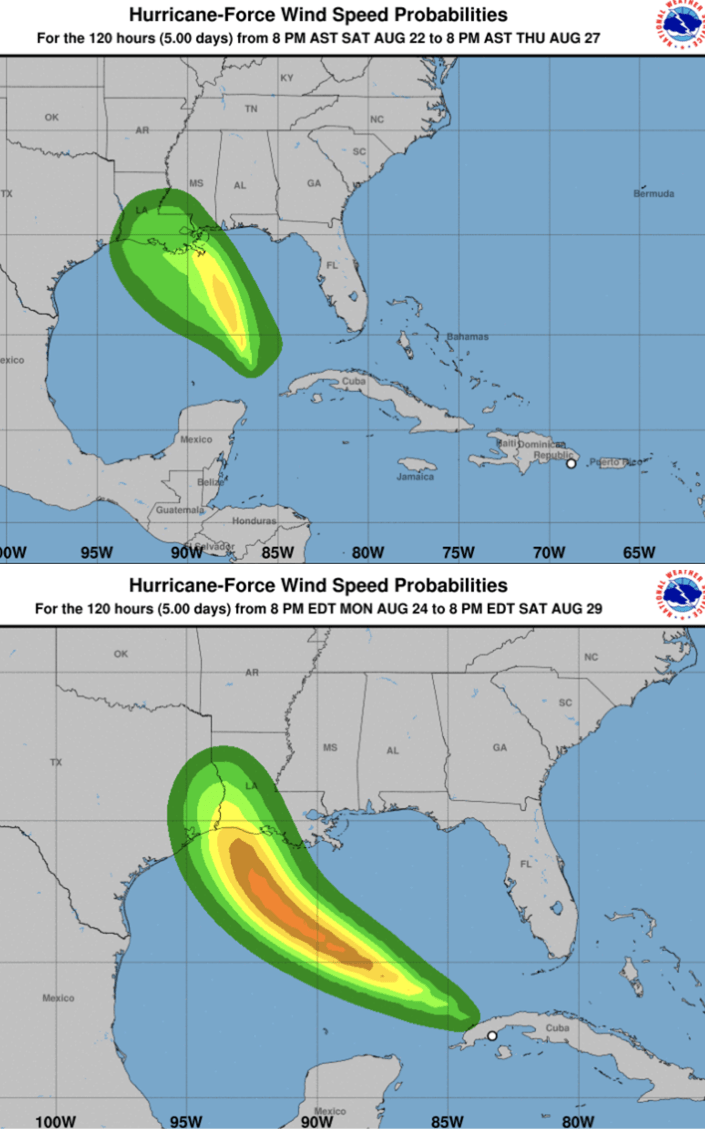
Aircraft instrument measurements captured the complete evolution of the major Hurricane Laura, from the system’s infancy to its landfall, which allowed for numerous additional IFEX experiments and modules to be performed.
Rob Rogers, a project PI for the Analysis of Intensity Change Processes Experiment (AIPEX), describes that “NOAA P-3 and G-IV data allowed their team to characterize the structure and evolution of Laura’s inner-core and its interaction with the environment throughout its lifecycle.” Key goals for AIPEX were addressed, emphasizing that measurement coverage within the system followed necessary requirements for the experiment’s design.

Covering Laura from a tropical depression east of the Windward islands, its interactions with the terrain and topography of Hispaniola and Cuba, its rapid intensification in the Gulf of America, and its landfall as a Category-4 hurricane, the observations from onboard TDR and high-altitude dropsondes from NOAA’s G-IV will allow researchers to explore how Laura organized its inner core and intensified in the Gulf of America despite the presence of vertical shear and dry air nearby (learn more here).
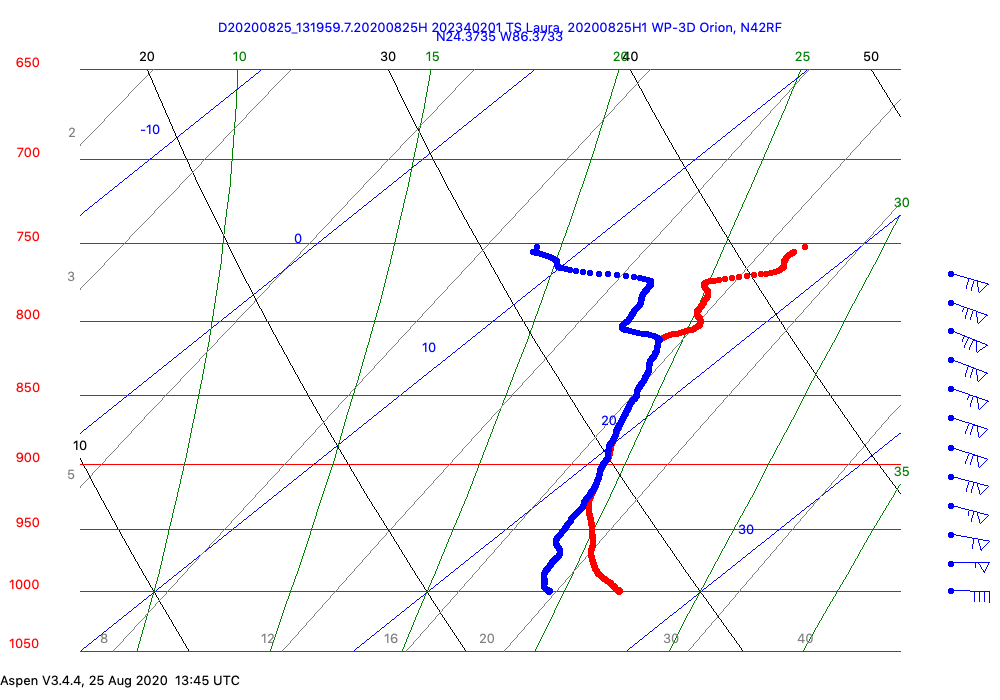
After major Hurricane Laura’s impressive rapid intensification, AOML hurricane experts were able to collect data aimed at understanding the characteristics of its mature structure.
Heather Holbach, project PI for AOML’s Surface Wind Speed and Significant Wave Height Experiment, states that “by releasing multiple dropsondes in a row into the major hurricane’s eyewall, we can compare wind values that each instrument collects in order to validate accuracy and identify potential issues in their retrieval.”
This approach was particularly important for Hurricane Laura, where dropsonde-derived measurements will be added to an accumulating database created to increase the accuracy of the SFMR measurements during extreme wind conditions.

The rapid-fire dropsonde strategy also proved useful for the Eye-Eyewall Mixing module, which aims at learning about the processes that dictate the exchange of energy between the moist and warm low-level eye and the very saturated and unstable eyewall.
As the module’s PI, Sim Aberson, PhD, explains, “Within the eyewall of a hurricane, small intense circulations called mesovortices can temporarily increase the wind speeds in localized regions.” These small-scale features cannot be resolved in numerical models but may contribute to the evolution of the TC.
Finally, as major Hurricane Laura approached the Gulf Coast for landfall, AOML hurricane scientists coordinated with collaborators from University of Oklahoma (OU) for their TCs at Landfall experiment to deploy land-based instrumentation in the projected path of the system. The complex flight pattern flown just prior to Hurricane Laura’s landfall was modified in real-time to collect additional observations offshore of the land-based mobile teams (learn more here).
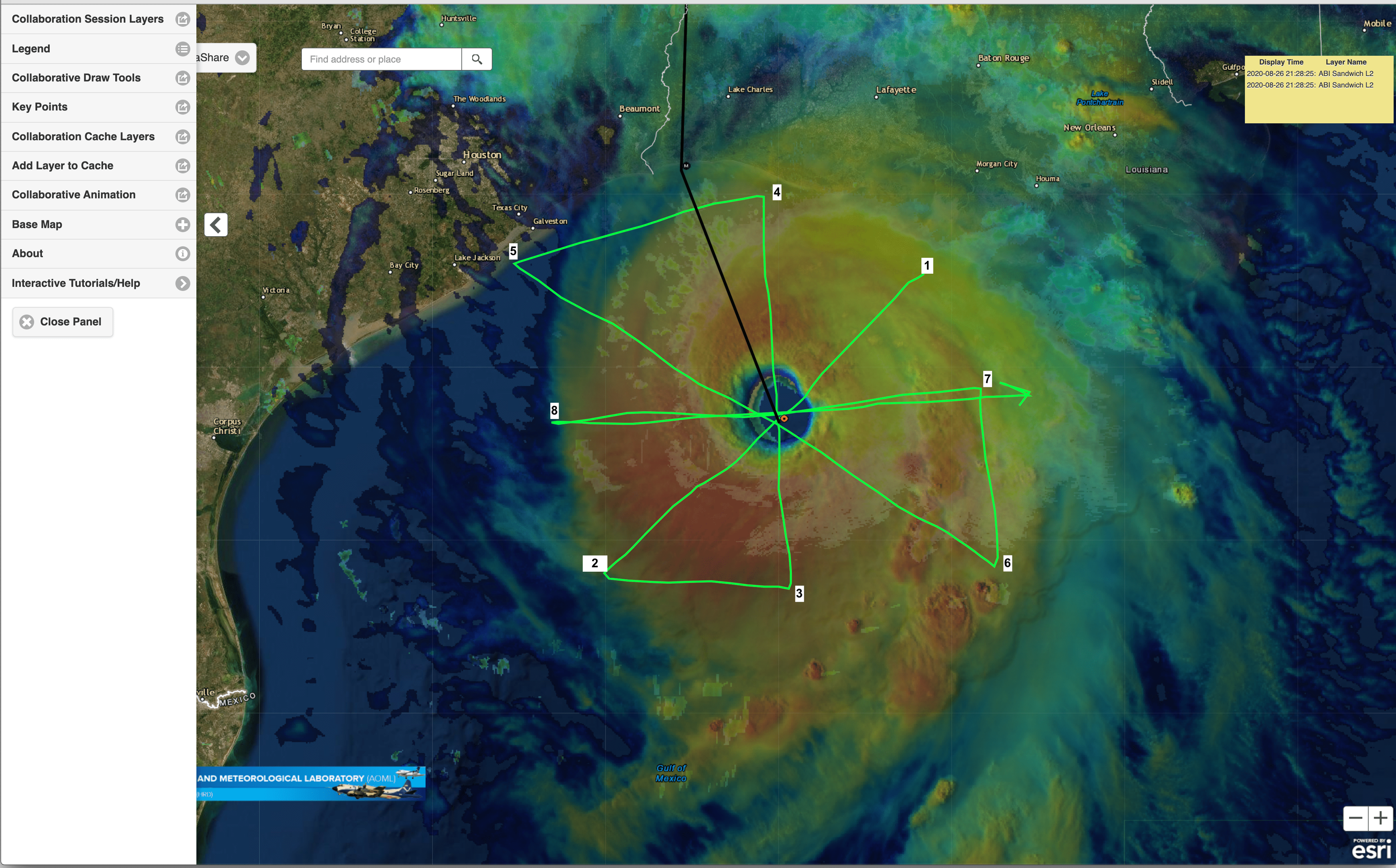
Project PIs for the Landfall experiment, John Kaplan and Peter Dodge, describe that supplementary dropsondes were launched in the dual-Doppler lobe of the mobile OU Doppler radar and the National Weather Service radar at Lake Charles. Dropsonde data will be used to validate surface wind reductions in the dual Doppler radar analyses. Kaplan stresses that “these data will be useful for research conducted at the other ground-based stations and for federal teams that were deployed along the path of landfalling Hurricane Laura.”

Critical data collected in major Hurricane Laura would not be available without the regular support of AOML ground crews, AOC flight crews, and the combined efforts of NOAA offices and their collaborators.
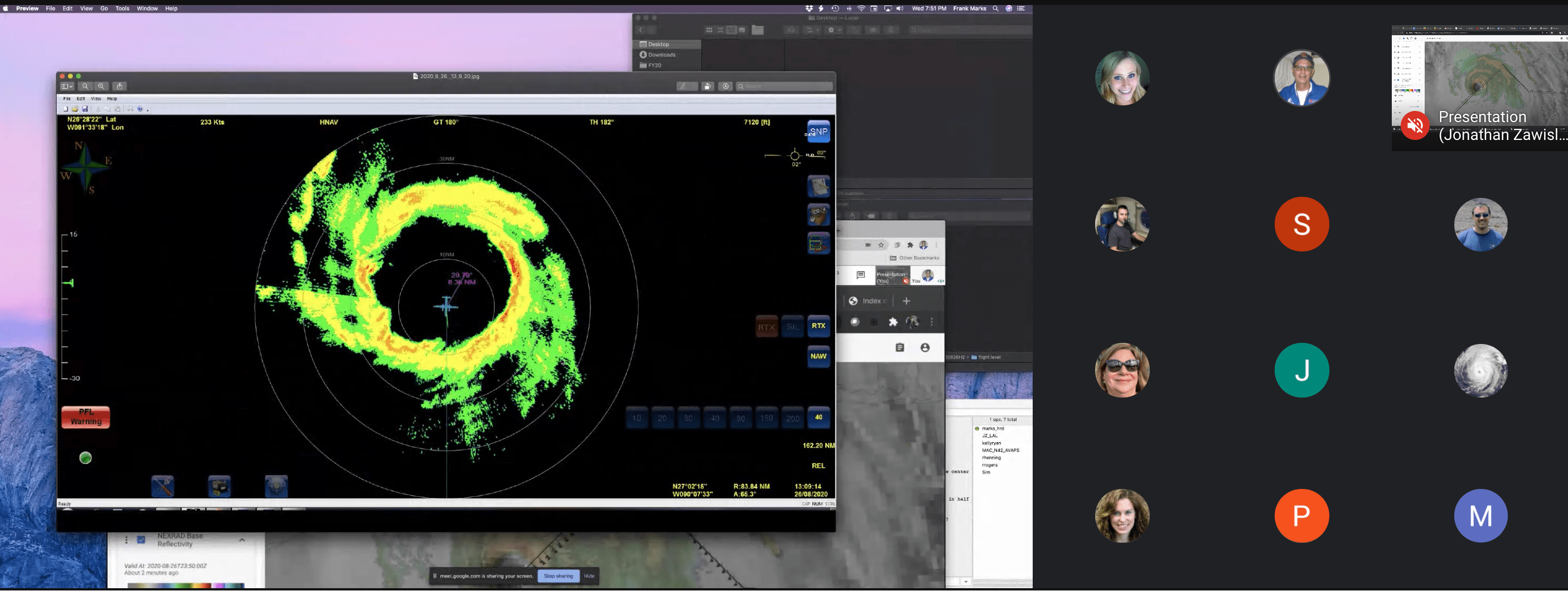
AOML thanks University of Wisconsin collaborators for their informative forecast discussion which aided in NOAA’s decision to target Hurricane Laura, and sincerely appreciates the hard work of its hurricane experts who supported these missions through the day and night, conducting science in service of society.
>> Scientist K. Ryan
HRD Ground Crews:
Director: L. Bucci
Deputy Directors/Trainers: J. Dunion, J. Zawislak
Lead Project Scientists: T. Alvey, A. Hazelton, F. Marks, R. Rogers
Dropsondes: B. Dahl, K. Ryan, K. Sellwood
Tail Doppler Radar: T. Alvey, J. Gamache, N. Griffin, P. Reasor
HFP Collaborators:
University of Miami, Cooperative Institute for Marine and Atmospheric Studies, Miami, FL
University of Albany, Albany, NY
University of Oklahoma, Norman, OK
University of Wisconsin, Madison, WI
National Center for Atmospheric Research, Boulder, CO
ProSensing, Tallahassee, FL

For the latest information about tropical cyclones and other weather systems, please visit the NOAA/NWS/National Hurricane Center.
For information on numerical prediction of tropical cyclones, please visit NOAA/NCEP/Environmental Modeling Center.
To access updates on the Intensity Forecasting EXperiment (IFEX) and other activities via Facebook, Twitter, or RSS feed, check out the NOAA/AOML/HRD page.
To directly access updates on IFEX HFP Operations via our WordPress blog on the web, check the site: https://noaahrd.wordpress.com/category/ifex-hurricane-field-program/
DISCLAIMER: The above discussion is intended to provide a brief summary of recent and future HRD Hurricane Field Program Operations. Any use of this material beyond its original intent is prohibited without permission of the HRD Director, Frank Marks (Frank.Marks@noaa.gov). Media inquiries should be directed to AOML Communications (aoml.communications@noaa.gov), Monica Allen (301-734-1123) or Monica.Allen@noaa.gov.